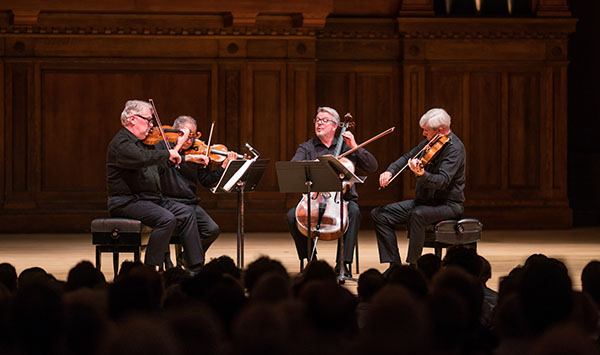by Daniel Hathaway
Nearing the end of their distinguished 47-year run with only one change of personnel, the Emerson String Quartet bid adieu to its local fans in a nostalgic yet festive program that launched Oberlin’s Artist Recital Series on Friday, September 22 in Finney Chapel.
The Emersons (Philip Setzer and Eugene Drucker — who have always shared first violin duties — violist Lawrence Dutton, and cellist Paul Watkins — who replaced David Finckel for the past decade) gave the capacity audience parting gifts of Mendelssohn, Sarah Kirkland Snider, and Beethoven. Plus an exquisite Bach chorale arrangement which should linger long in many listeners’ memories.
With Setzer in the driver’s seat, the Emersons began the evening with one of the quartet’s favorites, Mendelssohn’s Op. 13 in a minor, reminding us of their burnished tone, signature blend, and perfect ensemble, which remains intact after four and a half decades. Full of expressive detail, the piece might be heard to its best advantage in a more intimate hall, but by fewer pairs of ears. One special moment: Setzer’s cadenza leading into the last-movement Adagio.
Sarah Kirkland Snider was already a longtime Emerson Quartet fan when the ensemble commissioned her to write what would become her second string quartet. As she wrote in the program notes,
The title is a playful nod to one of the most famous quotes by their transcendentalist namesake essayist/philosopher/poet, Ralph Waldo Emerson: ‘Live in the sunshine, swim the sea, Drink the wild air’s salubrity.’
Quietly exuberant, Drink the Wild Ayre gave Paul Watkins an eloquent solo opportunity over long-held notes and pizzicato violins. Its lilting, asymmetrical rhythms convincingly represent what Snider describes as “the questing spirit, sense of adventure, and full-hearted passion with which the Emerson has thrown itself into everything it has done for the past 47 years.”
In addition to the Snider commission, this momentous occasion demanded a late Beethoven quartet, and the Emersons chose Op. 130 with its original finale, the notorious Große Fuge. (The composer’s publisher took one look and asked Beethoven for an alternative ending which would be more sellable to Artaria’s clientele.)
The front end of Op. 130 is a collection of movements including a Presto (played on Friday with amazing blend), a German dance (with nice trading of melodic elements), and the famous Cavatina (emotionally akin to the Adagio from Mahler 5, and played with heart-wrenching expression).
In an interview with this publication, Philip Setzer planted his tongue in his cheek and described the Große Fuge as “that cute little finale,” but went on to say,
“the Große Fuge is exhausting, but I always feel that going from the otherworldly beauty of the Cavatina to the Fugue is like the jaws of hell opening. You fall in and then you claw your way out at the end. There’s just such an incredible drama to that. I can only imagine what the Große Fuge sounded like at the premiere.”
Probably nothing like the Emerson’s magisterial performance in Finney, which reined in the wildness of the 15-minute-long double fugue just enough to let its incessant dotted rhythms lock into chords.
Afterward, Eugene Drucker addressed brief remarks to the audience, and Paul Watkins won over any listeners who weren’t already sold on the Emerson by mentioning that his daughter was an “Obie.”
As an extra, the quartet gave the crowd an elegant performance of the organ chorale Vor deinen Thron tret ich hiermit, dictated by the now-blind J.S. Bach on his deathbed, and published as the last piece in his unfinished Art of Fugue.
The Emerson Quartet might well have decided to hang on for three more years until it could celebrate its 50th anniversary, but as Setzer told us in that interview, “We feel like we’re still playing and getting along well, and you want to stop before somebody tells you you should have quit long before.”
A wise philosophy — worthy of the quartet’s namesake.
Published on ClevelandClassical.com September 28, 2023.
Click here for a printable copy of this article





